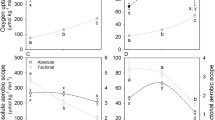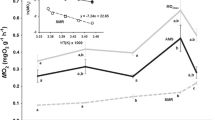Summary
Five species of antarctic fishes can be arranged in order of increasing anaerobic capacity of the white muscles for burst swimming: Rhigophila dearborni (Zoarcidae), icefish (Channichthyidae), Dissostichus mawsoni, Trematomus centronotus, and Pagothenia borchgrevinki (Nototheniidae). This order reflects increasing dependence on anaerobic work done during short bursts of speed during prey capture or predator avoidance. Buffer capacity (β) for white muscle was lower than that of behaviourally equivalent fish from lower latitudes and β is itself temperature-dependent.
Similar content being viewed by others
References
Abe H, Dobson GP, Hoeger U, Parkhouse WS (1985) Role of histidinerelated compounds to intracellular buffering in fish skeletal muscle. Am J Physiol 249:R449-R454
Baldwin J, Jardel J-P, Montague T, Tomkin R (1984) Energy metabolism in penguin swimming muscles. Mol Physiol 6:33–42
Blaxter JHS, Wardle CS, Roberts BL (1971) Aspects of the circulatory physiology and muscle systems of deep-sea fish. J Mar Biol Assoc UK 51:991–1006
Castellini MA, Somero GN (1981) Buffering capacity of vertebrate muscle: correlations with potentials for anaerobic function, J Comp Physiol B 143:191–198
Clarke A, Doherty N, DeVries AL Eastman JT (1984) Lipid content and composition of three species of antarctic fish in relation to buoyancy. Polar Biol 3:77–83
Dacie JV, Lewis SM (1975) Practical haematology, 5th edn. Churchill Livingstone, London, 629 pp
Davison W, Macdonald JA (1985) A histochemical study of the swimming musculature of Antarctic fish. NZ J Zool 12:473–483
DeWitt HH (1971) Coastal and deep-water benthic fishes of the Antarctic. Antarctic Map Folio Ser, Folio. 15. American Geographical Society, New York, pp 1–10
Dobson GP Wood SC, Daxboeck C, Perry SF (1986) Intracellular buffering and oxygen transport in the pacific blue marlin (Makaira nigricans): adaptations to high-speed swimming. Physiol Zool 59:150–156
Douglas EL, Peterson KS, Gysi JR, Chapman DJ (1985) Myoglobin in the heart tissue of fishes lacking hemoglobin. Comp Biochem Physiol A 81:885–888
Dunn JF, Johnston IA (1986) Metabolic constrants on burst-swimming in the Antarctic teleost Notothenia neglecta. Marine Biol 91:433–440
Eastman JT, DeVries AL (1982) Buoyancy studies of notothenioid fishes in McMurdo Sound, Antarctica. Copeia 1982:385–393
Eastman J, DeVries AL (1985) Adaptations for cryopelagic life in the antarctic notothenioid fish Pagothenia borchgrevinki. Polar Biol 4:45–52
Hazel JR, Garlick WS, Sellner PA (1978) The effects of assay temperature upon the pH optima of enzymes from poikilotherms: a test of the imidazole alphastat hypothesis. J Comp Physiol B 123:97–104
Hochachka PW, Mommsen TP (1983) Protons and anaerobiosis. Science 219:1391–1397
Johnston IA (1985) Temperature, muscle energetics and locomotion in inshore antarctic fish. Oceanis 11:125–142
Lin Y, Dobbs GH, DeVries AL (1974) Oxygen consumption and lipid content in red and white muscles of antarctic fishes. J Exp Zool 189:379–385
Lykkeboe G, Johansen K (1975) Comparative aspects of buffering capacity in muscle. Respir Physiol 25:353–361
Macdonald JA, Montgomery JC, Wells RMG (1987) Comparative physiology of Antarctic fishes. Adv Mar Biol 24:321–388
Montgomery JC, Macdonald JC (1984) Performance of motor system in Antarctic fishes. J Comp Physiol A 154:241–248
Tetens V, Wells RMG, DeVries AL (1984) Antarctic fish blood: respiratory properties and the effects of thermal acclimation. J Exp Biol 109:265–279
Walesby NJ, Nicol CJM, Johnston IA (1982) Metabolic differentiation of muscle fibres from a haemoglobinless (Champsocephalus gunnari Lonnberg) and a red-blooded (Notothenia rossii Fischer) Antarctic fish. Br Antarct Surv Bull 51:201–214
Wells RMG (1986) Cutaneous oxygen uptake in the antarctic icequab, Rhigophila dearborni (Pisces: Zoarcidae). Polar Biol 5:175–179
Wells RMG (1987) Respiration of antarctic fishes from McMurdo Sound. Comp Biochem Physiol 88A:417–424
Wells RMG, Tetens V, DeVries AL (1984) Recovery from stress following capture and anaesthesia of antarctic fish: haematology and blood chemistry. J Fish Biol 25:567–576
Author information
Authors and Affiliations
Rights and permissions
About this article
Cite this article
Wells, R.M.G., Summers, G., Beard, L.A. et al. Ecological and behavioural correlates of intracellular buffering capacity in the muscles of antarctic fishes. Polar Biol 8, 321–325 (1988). https://doi.org/10.1007/BF00442022
Received:
Accepted:
Issue Date:
DOI: https://doi.org/10.1007/BF00442022




